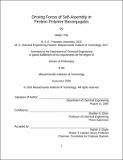Driving forces of self-assembly in protein-polymer bioconjugates
Author(s)
Yao, Helen,Ph. D.Massachusetts Institute of Technology.
Download1249657856-MIT.pdf (17.86Mb)
Other Contributors
Massachusetts Institute of Technology. Department of Chemical Engineering.
Advisor
Bradley D. Olsen.
Terms of use
Metadata
Show full item recordAbstract
Protein-polymer bioconjugates have shown great promise as high-performance biomaterials, with a diverse range of applications. Bioconjugation to a polymer allows the protein to maintain or even enhance its activity while imparting self-assembly capabilities to the overall material, which provide control over the orientation and nanostructure of the bioconjugates, enabling the design of materials with superior transport properties and high stability. The phase behavior of globular protein-polymer bioconjugates is comparable to that of traditional synthetic polymer block copolymers and leads to the formation of many of the same nanostructures. Despite these similarities, there are also key differences between these systems. The phase behavior of protein-polymer bioconjugates is affected by coarse-grained properties of both the protein and polymer. However, a unifying theory describing the self-assembly of these materials does not yet exist. The goal of this thesis was to understand interaction-based and structural driving forces of bioconjugate self-assembly. Partial structure factor analysis and subsequent inverse Fourier transformation showed that protein-polymer interactions could be quantified and understood in the context of physical phenomena through a real-space correlation function. The nature of these interactions can affect the propensity of a bioconjugate system to order. Polymer-water interactions were probed using small-angle neutron scattering, which showed that polymer hydration is affected by both polymer chemistry and concentration. This dependence likely underpins the significant effect that polymer chemistry has on self-assembly. On the structural side, the self-assembly of protein-rod block copolymers was investigated by imparting secondary structure to the polymer through chirality. The rigidity of the rod block was shown to drive self-assembly in inherently weakly segregated systems. Finally, a hard sphere-soft sphere dumbbell model for protein-polymer bioconjugates was built to understand the role of coarse-grained structural properties in phase behavior. Molecular dynamics simulations reproduced the most notable features of bioconjugate self-assembly, including an asymmetrical phase diagram and a lyotropic reentrant order-disorder transition at high concentrations. The success of this coarse-grained model revealed that colloidal interactions are sufficient to effect self-assembly in the globular protein-polymer block copolymer system.
Description
Thesis: Ph. D., Massachusetts Institute of Technology, Department of Chemical Engineering, September, 2020 Cataloged from the official PDF of thesis. Includes bibliographical references.
Date issued
2020Department
Massachusetts Institute of Technology. Department of Chemical EngineeringPublisher
Massachusetts Institute of Technology
Keywords
Chemical Engineering.